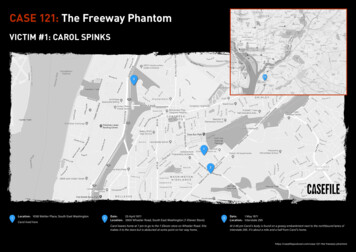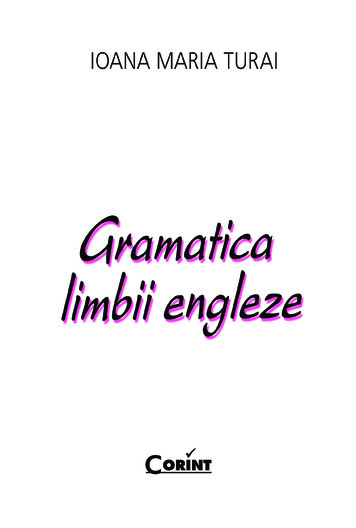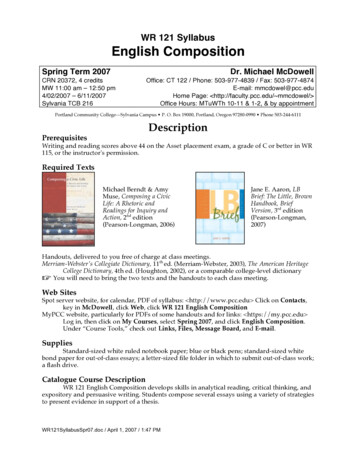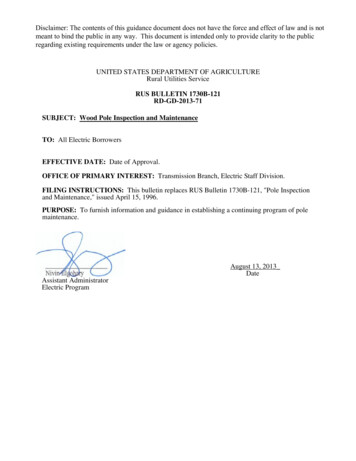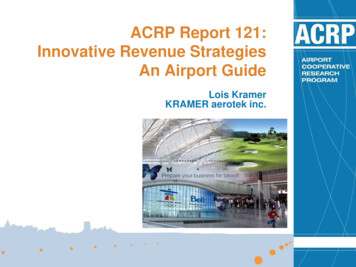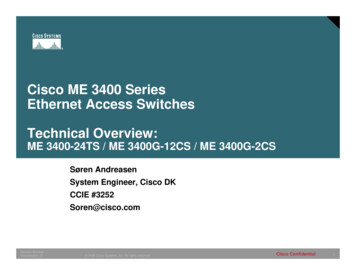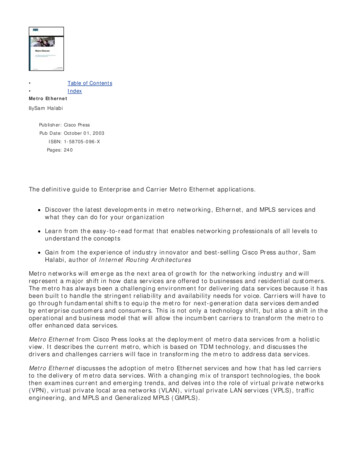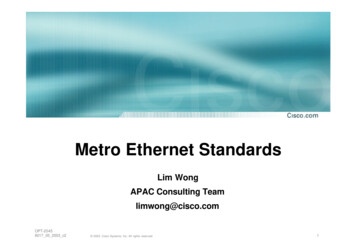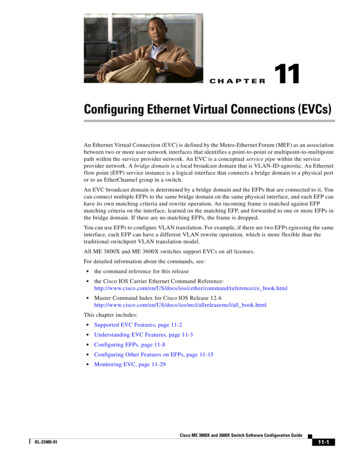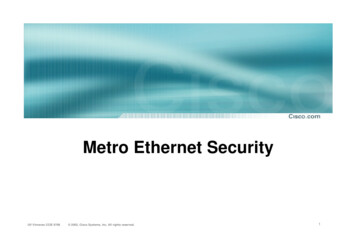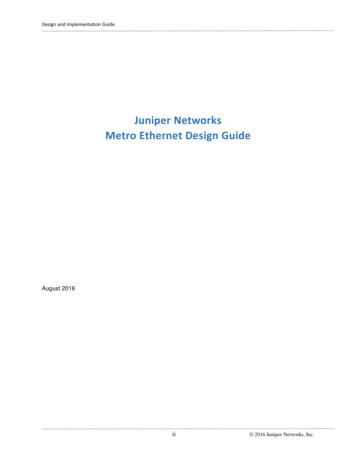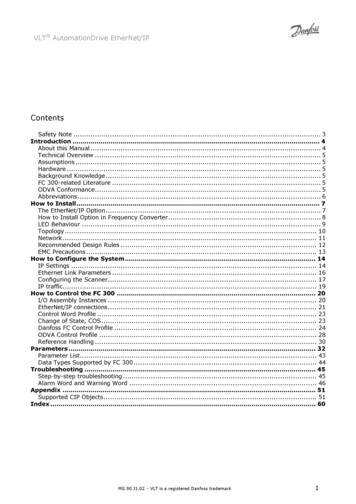
Transcription
VLT AutomationDrive EtherNet/IPContentsSafety Note . 3About this Manual. 4Technical Overview . 5Assumptions. 5Hardware . 5Background Knowledge. 5FC 300-related Literature . 5ODVA Conformance. 5Abbreviations. 6How to Install. 7The EtherNet/IP Option. 7How to Install Option in Frequency Converter. 8LED Behaviour . 9Topology. 10Network. 11Recommended Design Rules . 12EMC Precautions. 13How to Configure the System. 14IP Settings . 14Ethernet Link Parameters . 16Configuring the Scanner. 17IP traffic. 19How to Control the FC 300 . 20I/O Assembly Instances . 20EtherNet/IP connections. 21Control Word Profile . 23Change of State, COS. 23Danfoss FC Control Profile . 24ODVA Control Profile . 28Reference Handling . 30Parameters. 32Parameter List. 43Data Types Supported by FC 300. 44Troubleshooting . 45Step-by-step troubleshooting. 45Alarm Word and Warning Word . 46Appendix . 51Supported CIP Objects. 51Introduction . 4Index. 60MG.90.J1.02 – VLT is a registered Danfoss trademark1
VLT AutomationDrive EtherNet/IPCopyright, Limitation of Liability and Revision RightsThis publication contains information proprietary to Danfoss A/S. By accepting and using this manualthe user agrees that the information contained herein will be used solely for operating equipment fromDanfoss A/S or equipment from other vendors provided that such equipment is intended forcommunication with Danfoss equipment over an Ethernet serial communication link. This publication isprotected under the Copyright laws of Denmark and most other countries.Danfoss A/S does not warrant that a software program produced according to the guidelines providedin this manual will function properly in every physical, hardware or software environment.Although Danfoss A/S has tested and reviewed the documentation within this manual, Danfoss A/Smakes no warranty or representation, either express or implied, with respect to this documentation,including its quality, performance, or fitness for a particular purpose.In no event shall Danfoss A/S be liable for direct, indirect, special, incidental, or consequentialdamages arising out of the use, or the inability to use information contained in this manual, even ifadvised of the possibility of such damages. In particular, Danfoss A/S is not responsible for any costsincluding but not limited to those incurred as a result of lost profits or revenue, loss or damage ofequipment, loss of computer programs, loss of data, the costs to substitute these, or any claims bythird parties.Danfoss A/S reserves the right to revise this publication at any time and to make changes in itscontents without prior notice or any obligation to notify previous users of such revisions or changes.MG.90.J1.02 – VLT is a registered Danfoss trademark2
VLT AutomationDrive EtherNet/IPSafety NoteThe voltage of the frequency converter is dangerous whenever connected to mains. Incorrectinstallation of the motor, frequency converter or fieldbus may cause damage to the equipment,serious personal injury or death. Consequently, the instructions in this manual, as well asnational and local rules and safety regulations, must be complied with.Safety Regulations1. The frequency converter must be disconnected from mains if repair work is to be carried out. Checkthat the mains supply has been disconnected and that the necessary time has passed before removingmotor and mains plugs.2. The [OFF] key on the control panel of the frequency converter does not disconnect the equipmentfrom mains and is thus not to be used as a safety switch.3. Correct protective earthing or grounding of the equipment must be established, the user must beprotected against supply voltage, and the motor must be protected against overload in accordancewith applicable national and local regulations.4. The earth leakage currents are higher than 3.5 mA.5. Protection against motor overload is not included in the factory setting. If this function is desired,set par. 1-90 to data value ETR trip or data value ETR warning.Note: The function is initialised at 1.16 x rated motor current and rated motor frequency. For theNorth American market; the ETR functions provide class 20 motor overload protection in accordancewith NEC.6. Do not remove the plugs for the motor and mains supply while the frequency converter isconnected to mains. Check that the mains supply has been disconnected and that the necessary timehas passed before removing motor and mains plugs.7. Please note that the frequency converter has more voltage inputs than L1, L2 and L3, when loadsharing (linking of DC intermediate circuit) and external 24 V DC have been installed. Check that allvoltage inputs have been disconnected and that the necessary time has passed before commencingrepair work.Warning against Unintended Start1. The motor can be brought to a stop by means of digital commands, bus commands, references or alocal stop, while the frequency converter is connected to mains.If personal safety considerations make it necessary to ensure that no unintended start occurs, thesestop functions are not sufficient.2. While parameters are being changed, the motor may start. Consequently, the [OFF] key mustalways be activated.3. A motor that has been stopped may start if faults occur in the electronics of the frequencyconverter, or if a temporary overload or a fault in the supply mains or the motor connection ceases.Warning:Touching the electrical parts may be fatal - even after the equipment has been disconnectedfrom mains.Also make sure that other voltage inputs have been disconnected, such as external 24 V DC, loadsharing (linkage of DC intermediate circuit), as well as the motor connection for kinetic back up.Please take note of discharge times and further safety guidelines from the section: “Safety andconformity”, in the respective Design Guide (MG.33.Ax.yy).MG.90.J1.02 – VLT is a registered Danfoss trademark3
VLT AutomationDrive EtherNet/IPIntroductionAbout this ManualFirst time users can obtain the most essential information for quick installation and set-up in thesechapters:IntroductionHow to InstallHow to Configure the SystemFor more detailed information including the full range of set-up options and diagnosis tools pleaserefer to the chapters:How to Configure the SystemHow to Control the FC 100/200/300How to Access FC 100/200/300 ParametersParametersTroubleshootingTerminology:In this manual several terms for Ethernet is used.- EtherNet/IP, is the term used to describe the CIP/ODVA application protocol.- Ethernet, is a common term used to describe the physical layer of the network and does notrelate to the application protocol.MG.90.J1.02 – VLT is a registered Danfoss trademark4
VLT AutomationDrive EtherNet/IP-I n t r o d u c t i o n -Technical OverviewEtherNet/IP was introduced in 2001 and today is the most developed, proven and completeindustrial Ethernet network solution available for manufacturing automation.EtherNet/IP is a member of a family of networks that implements the Common Industrial Protocol(CIP ) at its upper layers. CIP encompasses a comprehensive suite of messages and services for avariety of manufacturing automation applications, including control, safety, synchronization, motion,configuration and information. As a truly media-independent protocol that is supported by hundreds ofvendors from around the world, CIP provides users with unified communication architecturethroughout the manufacturing enterprise.EtherNet/IP provides users with the network tools to deploy standard Ethernet technology formanufacturing applications while enabling Internet and enterprise connectivity.AssumptionsThese operating instructions are under the conditions that the Danfoss EtherNet/IP option is used inconjunction with a Danfoss FC 100/200/300 frequency converter, inclusive that the installed controllersupports the interfaces described in this document and that all the requirements stipulated in thecontroller, as well as the frequency converter, are strictly observed along with all limitations herein.HardwareThis manual relates to the EtherNet/IP option MCA121, type no. 130B1119 (un-coated) and 130B1219(coated).Background KnowledgeThe Danfoss EtherNet/IP Option Card is designed to communicate with any system complying with theCIP EtherNet/IP standard. Familiarity with this technology is assumed.Issues regarding hardware or software produced by other manufacturers, including commissioningtools, are beyond the scope of this manual, and are not the responsibility of Danfoss.For information regarding commissioning tools, or communication to a non-Danfoss node, pleaseconsult the appropriate manuals.FC 300-related LiteratureThe following literature is available for the FC 300 series:TitleLiterature no.FC 300 Operating InstructionsFC 300 Design GuideMG.33.Ax.yyMG.33.Bx.yyPlease also refer tions/-for additional information.ODVA ConformanceThe EtherNet/IP option is tested to conform to the ODVA standards, and is certified, towardsconformance test level version 3.MG.90.J1.02 – VLT is a registered Danfoss trademark5
VLT AutomationDrive EtherNet/IP-I n t r o d u c t i o n ARMAUMAVActual Packet IntervalControl CardCommon Industrial ProtocolControl WordDynamic Host ConfigurationProtocolEtherNet/IPElectromagnetic CompatibilityInput/OutputInternet ProtocolLocal Control PanelLight Emitting DiodeLeast Significant BitMajor Recoverable failMajor Unrecoverable failMain Actual Value 90.J1.02 – VLT is a registered Danfoss trademarkMost Significant BitMain Reference ValueNot applicableOpen DeviceNet VendorAssociationPersonal ComputerProgrammable Logic ControllerParameter NUmberReference ( MRV)Real Time ClockSpanning tree ProtocolStatus Word6
VLT AutomationDrive EtherNet/IPHow to InstallThe EtherNet/IP OptionMG.90.J1.02 – VLT is a registered Danfoss trademark7
VLT AutomationDrive EtherNet/IPHow to Install Option in Frequency ConverterItems required for installing a fieldbus option in the frequency converter:- The fieldbus option- Fieldbus option adaptor frame for the FC 100/200/300. This frame is deeper than the standardframe, to allow space for the fieldbus option beneath- Strain relief (only for A1 and A2 enclosures)Instructions:- Remove LCP panel from the FC 100/200/300.- Remove the frame located beneath and discard it.- Push the option into place. The Ethernet connectors must be facing upwards.- Remove both knock-outs on the fieldbus option adaptor frame.- Push the fieldbus option adaptor frame for the FC 100/200/300 into place.- Replace the LCP and attach cableN.B.:Do not strip the Ethernet cable and ground it via the strain relief-plate!The grounding of screened Ethernet cable is done through the RJ-45 connector on the option.N.B.:After installing the MCA121 option, be aware of the following parameter settings:Par. 8-01 Control Site[2] Controlword only or [0] Digital and ctrl. wordPar. 8-02 Control Word Source [3] Option AMG.90.J1.02 – VLT is a registered Danfoss trademark8
VLT AutomationDrive EtherNet/IPLED BehaviourThe option has 3 bi-coloured LED’s according to ODVA specifications:LED labelDescriptionMSNS1NS2Module StatusNetwork Status Ethernet Port 1Network Status Ethernet Port 2The option LED’s operates according to ODVA specifications.MS: Module StatusStateLEDNo powerDescriptionOffDeviceoperationalGreen: Solid greenStandbyGreen: Flashing greenMinor faultRed: Flashing redMajor faultRed: Red: Green: Solid redSelf testFlashing red/greenThe device is un-poweredThe device is operationalThe device needs commissioningThe device has detected a recoverablefaultThe device has detected a un-recoverablefaultThe EIP option is in self-test mode.NS1 NS2: Network status (one per port)StateLEDNo IP-address(no power)DescriptionOffNo connectionsGreen: Flashing greenConnectedGreen: Steady greenConnectiontime-outRed: Flashing redDuplicate IPRed: Steady redGreen: Flashing red/greenSelf testRed: The device does not have a valid IPaddress (or is un-powered)There are no established any CIPconnections to the deviceThere is established (at least) one CIPconnection to the deviceOne or more CIP connections has timedoutThe IP-address assigned to the device isalready in useThe EIP option is in self-test mode.During normal operation the MS and at least one NS LED will show a constant green light.MG.90.J1.02 – VLT is a registered Danfoss trademark9
VLT AutomationDrive EtherNet/IPTopologyThe MCA121 features a build-in Ethernet-switch, thus having two Ethernet RJ-45 connectors.This enables the possibility for connecting several EtherNet/IP options in a line topology as analternative to the typical star-topology.The two ports are equal, in the sense that they are transparent for the option. If only one connector isused, either port can be used.Star topologyLine topologyFor line topology please refer to section: “Recommended design rules”In a line topology all drives must be powered, either by mains or by their 24 V DC option cards,for the build-in switch to work.Note:MG.90.J1.02 – VLT is a registered Danfoss trademark10
VLT AutomationDrive EtherNet/IPRing/redundant line VLTAutomationDriveVLTAutomationDriveFor this type of topology it is crucial that the network switch supports Spanning TreeProtocol (STP), and that STP is enabled.For more information on Spanning Tree please refer to section IP traffic.N.B.:NetworkIt is of high importance that the media chosen for Ethernet data transmission are suitable.Usually CAT 5e and 6 cables are recommended for industrial applications. Both types of cable areavailable as Unshielded Twisted Pair and Shielded Twisted Pair.Generally shielded cables are recommended for use in industrial environments and with frequencyconverters.A maximum cable-length of 100 m is allowed between switches.Optical fibres can be used for gapping longer distances and providing galvanic isolation.For connecting EtherNet/IP devices both hubs and switches can be used.It is, however, recommended always to use suitable industrial graded Ethernet switches.For more information regarding IP-switching, please refer to section: IP Traffic in this manual.MG.90.J1.02 – VLT is a registered Danfoss trademark11
VLT AutomationDrive EtherNet/IPRecommended Design RulesWhile designing Ethernet networks special attention and caution must be taken regarding activenetwork components.While designing a network for line topology it is important to notice that a small delay is added witheach every switch in the line.For EtherNet/IP the maximum number of drives in a line is dependent of the API speed of theconnected scanner:According to the graph above, the network should thus be segmented with the use of externalEthernet switches.It is not recommended to connect more than 32 drives in a line at any API.Exceeding the recommended design rules, may result in failing communication.MG.90.J1.02 – VLT is a registered Danfoss trademark12
VLT AutomationDrive EtherNet/IPEMC PrecautionsThe following EMC precautions are recommended in order to achieve interference-free operation of theEthernet network. Additional EMC information is available in the FC 100/200/300 series Design Guide.N.B.:Relevant national and local regulations, for example regarding protective earth connection,must be observed.The Ethernet communication cable must be kept away from motor and brake resistor cables to avoidcoupling of high frequency noise from one cable to the other. Normally a dista
VLT AutomationDrive EtherN et/ IP - I n t r o d u c t i o n - MG.9 0.J1.0 2 VLT is a re gistere d D an foss t ra dem ar k 5 Technical Overview EtherNet/IP was introduced ni
